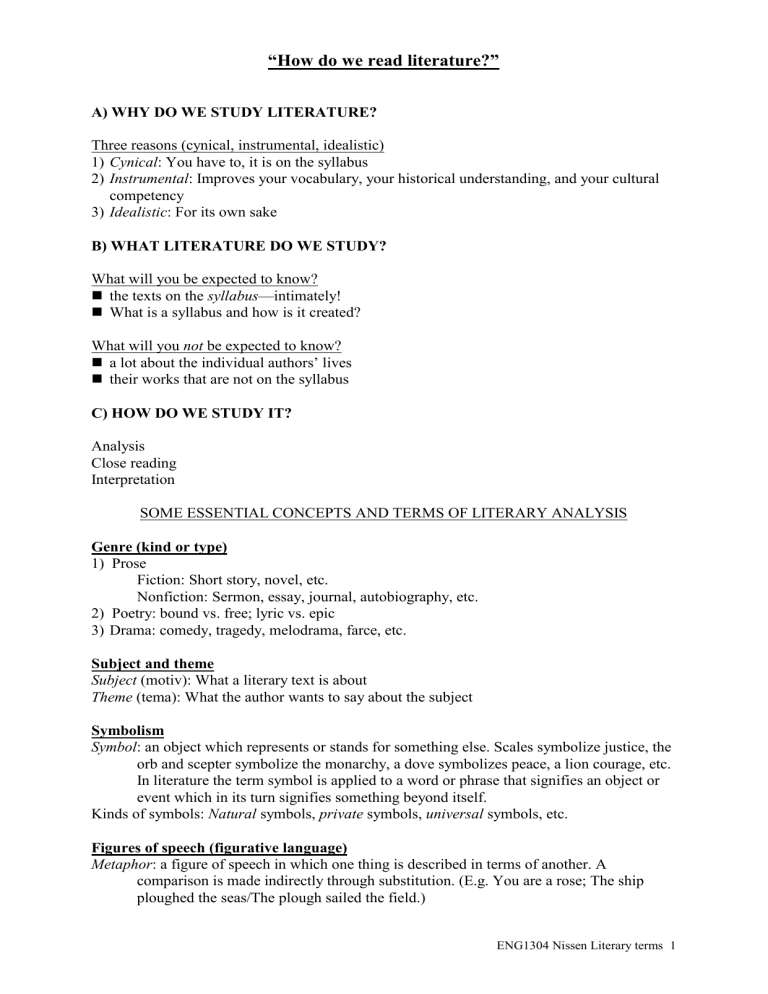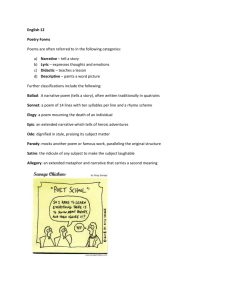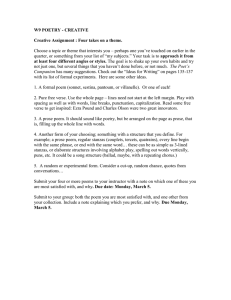
“How do we read literature?”
A) WHY DO WE STUDY LITERATURE?
Three reasons (cynical, instrumental, idealistic)
1) Cynical : You have to, it is on the syllabus
2) Instrumental : Improves your vocabulary, your historical understanding, and your cultural competency
3) Idealistic : For its own sake
B) WHAT LITERATURE DO WE STUDY?
What will you be expected to know?
the texts on the syllabus
—intimately!
What is a syllabus and how is it created?
What will you not be expected to know?
a lot about the individual authors’ lives
their works that are not on the syllabus
C) HOW DO WE STUDY IT?
Analysis
Close reading
Interpretation
SOME ESSENTIAL CONCEPTS AND TERMS OF LITERARY ANALYSIS
Genre (kind or type)
1) Prose
Fiction: Short story, novel, etc.
Nonfiction: Sermon, essay, journal, autobiography, etc.
2) Poetry: bound vs. free; lyric vs. epic
3) Drama: comedy, tragedy, melodrama, farce, etc.
Subject and theme
Subject (motiv): What a literary text is about
Theme (tema): What the author wants to say about the subject
Symbolism
Symbol : an object which represents or stands for something else. Scales symbolize justice, the orb and scepter symbolize the monarchy, a dove symbolizes peace, a lion courage, etc.
In literature the term symbol is applied to a word or phrase that signifies an object or event which in its turn signifies something beyond itself.
Kinds of symbols: Natural symbols, private symbols, universal symbols, etc.
Figures of speech (figurative language)
Metaphor : a figure of speech in which one thing is described in terms of another. A comparison is made indirectly through substitution. (E.g. You are a rose; The ship ploughed the seas/The plough sailed the field.)
ENG1304 Nissen Literary terms 1
Simile : a figure of speech in which one thing is explicitly and directly compared to another through the use of the word “like” or “as”. (E.g. You are like a rose.)
Metonymy : a figure of speech in which a literal part of something or a term with which it has become closely associated stands for the whole (E.g. The crowned heads of Europe;
Do you like Ibsen?)
Hyperbole (overdrivelse): a figure of speech which contains an exaggeration for emphasis.
(E.g. I haven’t seen you in ages; I’m going to kill you; She is old as the hills.)
Litotes or understatement (underdrivelse): the assertion of an affirmative by negating its contrary (E.g. not bad; He's not the brightest man in the world.)
Period/school/movement
What kinds of questions may we ask of a literary text?
Who wrote it?
When? In what period?
How was it written/published?
Who was it written for? Who read it?
What is its form, style, and structure? How does it use language?
What is it about? What are its subject and theme?
What has it meant to readers in the past? In the present? What does it mean to me?
How to analyze a narrative
1) What is narrative?
A story involving events, characters, and what characters say and do.
2) What kinds of narrative are there?
Fiction vs. non-fiction (novel, short story vs. autobiography, biography, and history)
Fiction is any literary narrative, whether in prose or verse, which is invented instead of being an account of events that in fact happened. In a narrower sense, however, fiction denotes only narratives that are written in prose (the novel and the short story), and sometimes is used simply as a synonym for the novel.
Prose narrative vs. poetic narrative
Prose is an inclusive term for all discourse, spoken or written, which is not patterned into the lines either of metric or free verse (i.e. which is not poetry).
=> Fictional, prose narrative => novel, short story
3) What are the chief elements of narrative?
Character, plot, point of view, and setting.
CHARACTER
Types of character:
ENG1304 Nissen Literary terms 2
Flat vs. round
Static vs. developing
Protagonist (hero/heroine); antagonist; foil
Manners of characterization: a) Direct--the reader is told directly what a character is like and what to think of him or her b) Indirect: i) By externals--e.g. physical appearance, surroundings ii) By speech--what a character says and how iii) By action--how a character acts, behaves, etc. iv) By revelation of thoughts (interior monologue; stream of consciousness)
PLOT
Plot : in a dramatic or narrative work is constituted by its events and actions, as these are rendered and ordered toward achieving particular artistic and emotional effects. Aristotle defined plot as “character in action.”
Story vs. discourse
Chronology: chronological vs. achronological
POINT OF VIEW
Point of view : signifies the way a story gets told; the mode (or modes) established by an author by means of which the reader is presented with the characters, dialogue, actions, setting, and events which constitute the narrative in a work of fiction => who tells the story and how.
Voice vs. perspective; Narrator vs. focalizer
Types of narrator: a) First-person i) central vs. peripheral (witness) ii) singular vs. plural/communal/collective (e.g. “I” vs. “we”) b) Third-person: omniscient vs. limited
SETTING
Setting : consists of the time (period, season, time of day, etc.) of the narrative and the place in which it is acted out.
How to interpret a poem
STRUCTURING YOUR INTERPRETATION
I. Contextualization
Who is the author? How does the poem relate to other poems by the same author? How does the poem relate to works by other authors? How does it relate to the period/movement/school to which it belongs?
ENG1304 Nissen Literary terms 3
II. Analysis a) Read the poem aloud to yourself. b) Make a paraphrase of the poem and/or a loose translation of the poem into Norwegian. c) Check on the meaning of words, expressions, and allusions you are unfamiliar with. d) Analyze the form of the poem (i.e. rhyme scheme, rhythm, imagery, symbolism, etc.)
III. Interpretation
What do you take to be the subject and the theme of the poem? What is its central idea? How does the form contribute to the meaning of the poem?
IV. Conclusion
Here you can either: a) Expand on Part I, interpreting the poem on the basis of what you know about the author, his or her other works, or the period. b) Give your personal evaluation of the poem.
KEY TERMS TO BE USED IN ANALYZING THE FORM OF A POEM (II d above)
Poetic sound patterns (apart from rhyme)
Alliteration : Repetition of the same consonant at the beginning of two or more words in a single line (e.g. b ad b oys; s ad s isters)
Consonance : Repetition of a sequence of two or more consonants, but with a change in the intervening vowel (e.g. I l i k e your l oo k ; j o lly j e lly )
Assonance : Repetition of the identical or similar vowels (especially in stressed syllables) in a sequence of words close to each other (e.g. Seize the sea you see)
Onomatopoeia : A word, or combination of words, whose sound resembles closely the sound it denotes (e.g. cock-a-doodle-doo; hee-haw; miaouw; click; crack)
Figures of speech (figurative language)
Metaphor : a figure of speech in which one thing is described in terms of another. A comparison is made indirectly through substitution. (E.g. You are a rose; The ship ploughed the seas/The plough sailed the field.)
Simile : a figure of speech in which one thing is explicitly and directly compared to another through the use of the word “like” or “as”. (E.g. You are like a rose.)
Metonymy : a figure of speech in which a literal part of something or a term with which it has become closely associated stands for the whole (E.g. The crowned heads of Europe;
Do you like Ibsen?; A heart in port)
Free verse : Verse with a) no fixed meter and b) no fixed rhyme scheme . Instead free verse makes use of various forms of repetition, be it the repetition of sounds (see below) or of words. The repetition of one or more words (usually at the beginning of a sentence) is called anaphora (e.g. Whitman’s poetry).
ENG1304 Nissen Literary terms 4


